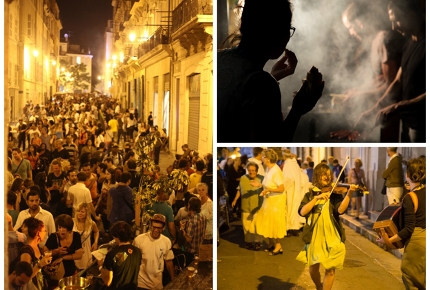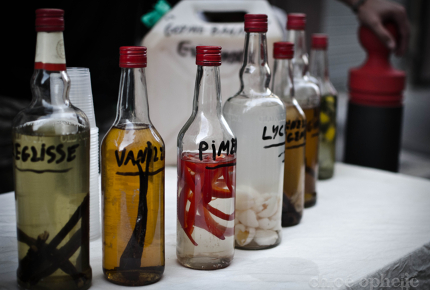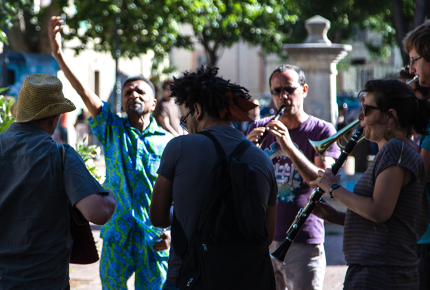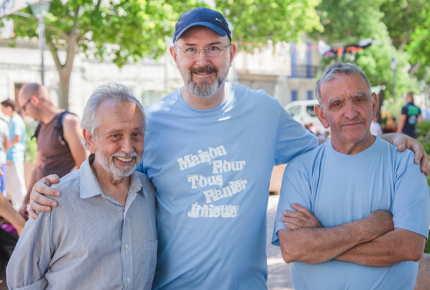Is the party over for France’s oldest street festival?
Facing budget cuts and a shift in cultural identity, is it curtains for Le Panier’s raucous street party? Chris Allsop, mojito in hand, investigates.
The three twenty-somethings operating the impromptu bar set up on Le Panier’s Rue du Refuge are working with the intense focus typical of a Michelin-starred kitchen. One slices limes; one chops mint; one mixes drinks for the growing mob of Saturday-night partyers thirsty for their €3 mojitos. Either side of them, and all the way along the street, barbecues are being lit while brass and beats born on the blustering mistral wind boom from the instruments of eclectic funk band Big Butt Fanfare.
It’s past 6 now in Marseille’s oldest neighbourhood, and denizens of the port city are about to find out if one of the longest-running block parties in France – despite a significant cut in funding and ongoing gentrification – is still one of the best.
The Fête d’Eté au Panier (Summer Feast of the Panier) is the new incarnation of the Fête du Panier – an event started in 1993 to promote civic unity among Le Panier’s diverse population.
 The event regularly draws over 40,000 guests
The event regularly draws over 40,000 guestsChris Allsop; Creative Commons / Steve
Over the centuries, Le Panier has soaked up impecunious immigrants mainly from North Africa, Corsica and Italy. During WWII, the area was a haven for Jews and resistance fighters while, more recently, its warren of honeyed limestone alleyways provided a stronghold for the Corsican mafia.
But, according to white-haired Maurice Vinçon, sipping a coke beneath the 29°C heat of a Marseille summer day, it’s been safe for the 40 years he’s been here, relatively speaking.
“Sure, sometimes there are robberies, the boom boom,” the former Fête du Panier organiser mimes a Tommy Gun and gently laughs. “But no more than the rest of Marseille.”
I imagine the mayor wincing. The city is desperate to shake off its “Chicago of the South” reputation, home of the French Connection and gangsters with names like “The Belgian” or “The Big Blond”. It appears this appetite for self-reinvention by local authorities is a strong factor for the changing face of the ageing street festival.
 A flamboyant array of drinks are on offer to attendees
A flamboyant array of drinks are on offer to attendeesCreative Commons / Ophelia photos
In 2013 the event, under Marseille’s Capital of Culture auspices, celebrated a raucous 20-year anniversary. But in 2014 it was cancelled, after organisers were told it was too expensive in the current format. It’s returned this year, now split into a programme of four smaller seasonal events of which Fête d’Eté au Panier is the sweaty summer rendition.
This apparent lack of funding - the Fête's 2013 budget of €550,000 was slashed to €160,000 for all four events - appears at odds with the area’s other recent developments, including the opening of the €191m Museum of European and Mediterranean Civilisations (MuCEM) and the costly clean-up of the Vieux Port, where Marseille’s architectural treasures cluster.
Le Panier, tucked in behind the Vieux Port, was also given a spruce up, with a fresh lick of paint on shutters. Consequently rents are on the rise, and new middle-class residents are moving in.
“It’s artificial now, the neighbourhood has become touristic,” complains Max, an accordion player with folk band and Fête du Panier regulars, Grive et Ours. “The multicultural way of life here is disappearing. The city of Marseille is only after money, it’s not protecting our culture. Big investments like Capital of Culture [are good] yes, but there isn’t any funding for smaller cultural events.” Max shrugs in Gallic fashion as Grive et Ours’s clarinets, trumpet, and accordion strike up a tune and wander away through Le Panier’s cobbled alleys, followed by a stream of mojito-clutching fans.
 Folk band Grive et Ours are Fête du Panier regulars
Folk band Grive et Ours are Fête du Panier regularsChris Allsop
Others are less downbeat about the area’s new shiny facade. Daniela, born in the quarter and now in her 50s, serves up punch and Chupa Chups lollypops from a stall run out of her front room. Similarly to many of the local residents, the festival provides Daniela with an opportunity to generate additional income.
“The renovations are good for Le Panier,” she says, her eyes sparkling in her tanned, lined face. “And now, instead of one, we have four parties!”
Her positivity reminds me of Rémy Dutherage, one of the organisers who helps run the local youth club. It’s earlier in the afternoon when I talk to Rémy, during the family programme in Place des Moulins with BMX riding and breakdancing in nearby Place du Refuge for the teens.
He explains to me that the event’s name was changed to moderate expectations, as the reduced funding means less money to spend on musical acts and marketing. Although that is not the only change he’s noticed.
“It has returned to a neighbourhood festival,” he says, emblazoned in the baby blue T-shirt sported by the event’s volunteer helpers. “Less for the city, and more for Le Panier.”
I ask him about the influx of middle-class residents, whether it’s affecting the neighbourhood’s spirit.
“These kinds of events are all the more important so that the different classes can mingle,” he replies. Overhead, the hand-painted banners billow like spinnakers.
 Rémy (middle) poses with miming-Maurice (left) and Alain
Rémy (middle) poses with miming-Maurice (left) and AlainChris Allsop
Back at the party, evening has fallen. The strips of indigo sky felting the space between Le Panier’s tall buildings are punched through with bright stars. Barbecues waft smoke, laser lights dance over the washed walls, while revellers drink pastis or the lurid cocktails on offer in old squash bottles. A pregnant woman in a headscarf has a tired, happy smile, her brick tunisiennes – fried wallets of potato, cheese, egg and parsley – near to selling out. Steam leaks from towering steel saucepans and cumin tangles in the mistral. People whoop as the wind whips up to almost gale force.
A tiny girl in a patterned blue dress comes up to me, trying to sell the last of her bunches of wildflowers, her mother smiling on. I’d be lying if I weren’t slightly relieved to have spent my last change on a pastis poured by Jerome.
As the traditional Marseillaise liquor pleasantly anaesthetises my mouth, Jerome – a veteran pastis purveyor of Le Panier parties past – confirms the reduced attendance.
“But the vibe is still here,” he smiles, pressing his white trilby to his head as the mistral charges by.
Partygoers continue to stream in, and in Place des Pistoles a crowd dances to the Trio Rocky Funky. At the Place des Moulins, the Feux de la Saint-Jean, a traditional religious procession is getting underway.
A violinist and accordion play while two horsemen lead a gang of eight locals bearing a statue of the saint shoulder high. But just as the procession is building steam, it halts. A poorly parked blue Polo blocks the route. The horsemen wheel around, confused, and I think of Maurice concerned that next year’s funding could be cut entirely; Max’s fears for Marseille’s obliterating appetite for the tourist euro. But a new route is found, the musicians strike up, and the procession finds a way to carry on.
 The party shall go on
The party shall go onChris Allsop
NEED TO KNOW
Getting there
The next event in the series is the La Fête d'Automne, held on the 26 September.
Easyjet flies to Marseille direct from London Gatwick. From £72.49 in high season, one way.
Eurostar offers a direct service to Marseille via Lyon and Avignon. From £79.50, one way. Updated trains with Wi-Fi are launching in November.
Where to stay
The Intercontinental Marseille – Hotel Dieu offers (at a price) luxurious rooms with spacious, high-ceilinged balconies offering Instagram-tastic views of glorious Notre Dame de la Garde.
Grand Hotel Beauvau is superbly positioned on the Vieux Port, and within the stately building you’ll find comfortable rooms and an excellent breakfast buffet.
More information
www.leolagrange-mptpanier.org
Do you have any Feedback about this page?
© 2025 Columbus Travel Media Ltd. All rights reserved. No part of this site may be reproduced without our written permission, click here for information on Columbus Content Solutions.









 You know where
You know where